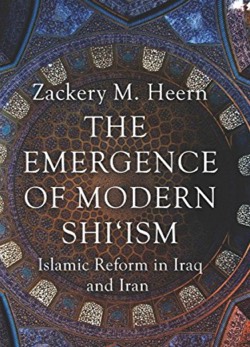
With The Emergence of Modern Shi’ism. Islamic Reform in Iraq and Iran (Oneworld, 2015), Professor Zachery Heern (Middle East and Islamic Studies, Idaho State University) has written an engaging essay on the little known story of the birth of the Shia neo-Usuli movement and its evolution from the late 18th century until its culmination into contemporary Shi’ism. The period between the late 18th century and the early 19th century was indeed a watershed moment in history, characterized by the emergence of modernity, monumental intellectual, social and political changes that deeply affected not only Europe, but also the Middle East and North Africa. An era of transformation and innovations that witnessed the birth of new reformative trends within Islam.
Heern’s social and intellectual history presents us with a subtle reading of how modernity not only impacted, but also arose within the Islamic world. Its particular value lies with the author’s close, granular study of the local and regional forces that contributed to the development of the neo-Usuli movement. He unearths the ways it grew as a spiritual, social and political movement from the wreckage of the Safavid Empire to eventually become state ideology under the Qajar, expanding its reach into Sunni Ottoman province of southern Iraq. The study operates like a core sample of Middle Eastern modern history more broadly, revealing the interactions and overlap between grand-scale socio-political shifts and local spiritual and intellectual reactions and innovations.
The decentralization and collapse of old empires opened a breathing space for innovative takes on traditions, jurisprudence, organizational structures and power relations. This new environment proved to be a fertile ground for three main reformist movements: neo-Sufism, initiated by Ahmad Ibn Idris al-Fasi (1760-1837) in Morocco, heir of the Shadhili Sufi tradition; Wahhabism (or neo-Hanbalism), a reformist view of the Sunni Hanbali school, developed after Muhammad Ibn ‘Abd al-Wahhab (1703-1792) in the Arabic Peninsula; and finally, neo-Usulism, a 11th century Shia school of jurisprudence rejuvenated under the guidance of Muhammad Baqir Behbahani (1706-1791) in present day Iraq.
These movements were spiritual as well as political endeavours, and as such, played a critical role in shaping a new political order. The Wahhabi movement became the religious pillar of the nascent Kingdom of Saudi Arabia, establishing a still very much living alliance with the Saudi clan. The Sanusiyya Sufi order, one of the Sufi schools established by pupils of Ibn Idris, saw one of their members, Muhammad Idris al-Sanusi (1890-1983), be crowned King Idris I of Libya in 1951. Usuli clerics ran the legal and educational systems under the Qajar (1785-1925), sometimes cooperating, sometimes opposing the dynasty, to eventually take control of the Iranian State after toppling in 1979 the regime of Mohammad Reza Shah Pahlavi (1919-1980).
Since the 19th century within the Shia world, Usulism has been the dominating school of thought and has reached a prominent position both in modern Iran and southern Iraq. One of the primary legacies of neo-Usulism has been the empowerment of a clerical class, whose transnational network of charities, schools and wealthy businesses were to become the organizational and ideological backbone of Ayatollah Khomeini’s rise to power in the early 1980s. Heir to the reformist impulse of the neo-Usuli movement, the new political system built in Iran by clerics was a unique – even modern – innovation in Islamic history.
Although not the primary thrust of Zackery Heern’s book, his comparative examination of early modern revivalist movements and their legacy will no doubt be of great interest to the more contemporary-minded reader. An engaging last chapter tackles the questions of contextual distinctions and commonalities between neo-Sufism, neo-Usulism and neo-Hanbalism. The author highlights that these three movements responded to a similar set of socio-political challenges caused by the profound political transformations in the region. Each of these movements had a critical influence on how new kingdoms were to be shaped – especially in the Arabian Peninsula and Iran. They aimed at rejuvenating their respective traditions, and in so doing, invariably narrowed the scope of what is considered Islamic orthodoxy. Eventually, these movements would become associated with the organizations today commonly deemed “Islamist” or “political Islam.”
A challenging and thought-provoking read.
Zackery M. Heern, The Emergence of Modern Shi’ism. Islamic Reform in Iraq and Iran, London: Oneworld, 2015.